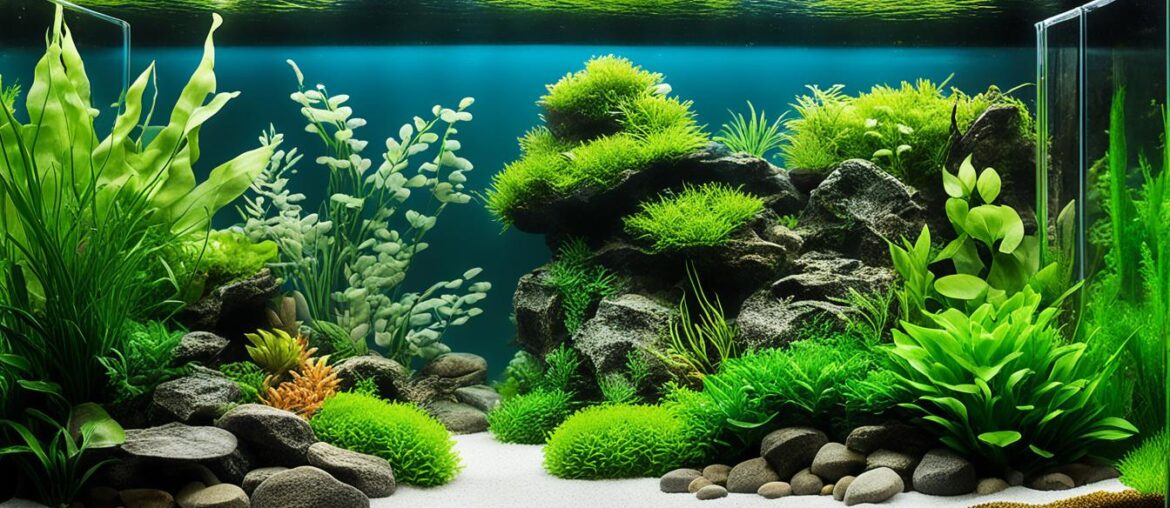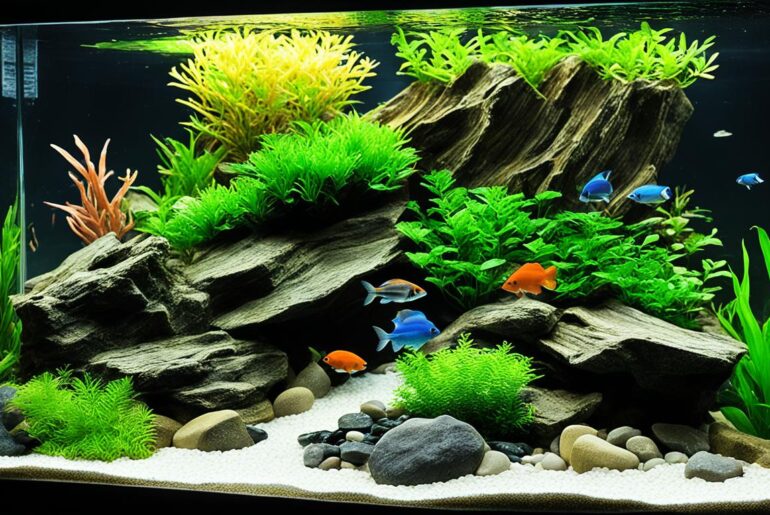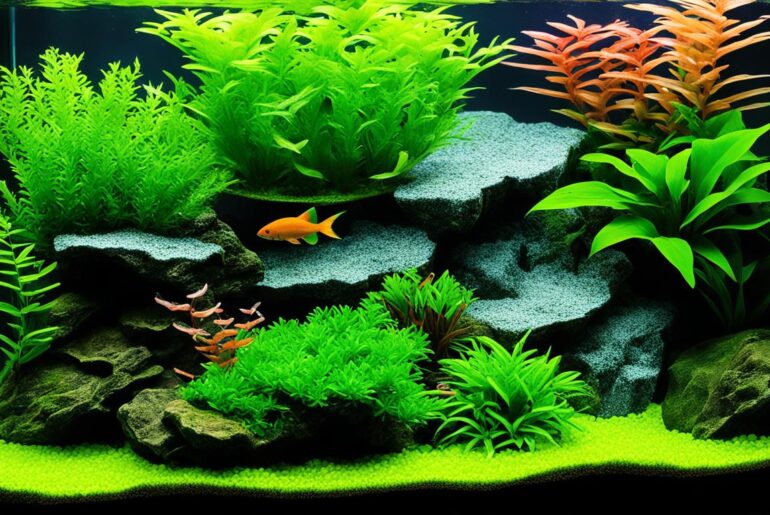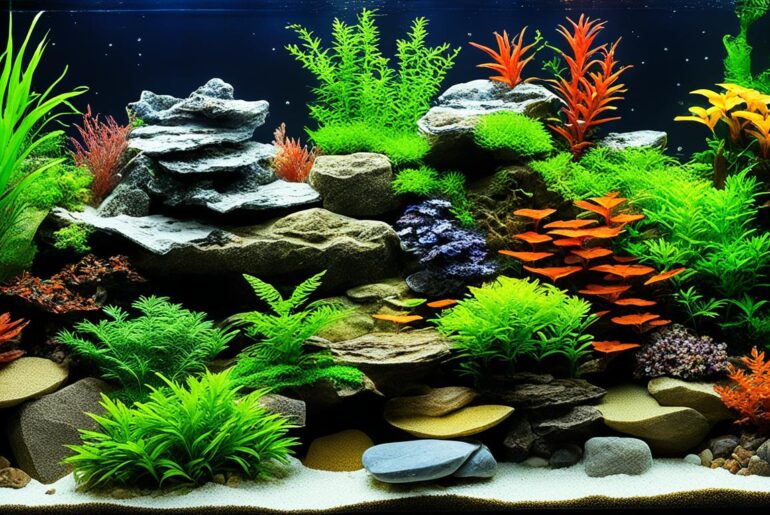Have you ever gazed at a beautifully landscaped aquarium and wondered how they created such a captivating underwater world? It’s a fascinating art, and I must admit, I was once daunted by the idea of achieving such intricate beauty in my own freshwater tank. But let me tell you, with the right guidance and a little creativity, anyone can master the art of substrate layering and transform their aquarium into a breathtaking aquatic paradise.
As an avid aquarium enthusiast, I have spent countless hours researching and experimenting with different substrate layering techniques. Through trial and error, I have discovered a simple three-step process that guarantees success in creating a thriving and visually stunning freshwater aquarium.
Join me on this journey as I uncover the secrets to creating a captivating substrate layer in your freshwater aquarium. Whether you’re a beginner or an experienced hobbyist, these steps will empower you to unleash your creativity and provide the ideal environment for your fish and aquatic plants to flourish.
Key Takeaways:
- Layering substrates in freshwater aquariums is an art that can be mastered with the right guidance.
- With a simple three-step process, you can create a thriving and visually stunning underwater world.
- Substrate layering provides the ideal environment for fish and aquatic plants to flourish.
- Whether you’re a beginner or an experienced hobbyist, these steps will empower you to unleash your creativity.
- Stay tuned as we dive into the exciting world of substrate layering in freshwater aquariums!
Why is Substrate Layering Important in Freshwater Aquariums?
Substrate layering plays a crucial role in creating a successful and thriving freshwater aquarium ecosystem. It offers numerous benefits that contribute to the health and aesthetics of the aquatic environment. Let’s explore why substrate layering is so important:
Supporting Plant Growth
One of the primary reasons for substrate layering is to provide a solid foundation for plants to grow. By creating multiple layers, we ensure that the roots have a stable substrate to penetrate and anchor, allowing plants to establish a strong foothold in the aquarium. This is essential for their overall health and longevity.
Nutrient Source for Aquatic Plants
The substrate serves as a valuable source of nutrients for aquatic plants. With a properly layered substrate, plants can access essential elements necessary for growth and development. These nutrients are released slowly over time, providing a continuous supply that helps promote healthy plant growth and vibrant foliage.
Enhanced Aesthetic Appeal
The artistry of substrate layering goes beyond functionality. By combining different materials and textures, we can create visually stunning effects in the aquarium. The layered substrate adds depth and dimension to the tank, mimicking natural underwater landscapes. The result is a visually appealing and captivating aquatic environment.
“Substrate layering not only provides support and nutrients for plants but also enhances the overall aesthetic appeal of the aquarium, creating a visually pleasing underwater landscape.” – Your Name
Creating a well-layered substrate is a fundamental step in setting up a freshwater aquarium. It provides the necessary foundation for plants, supplies essential nutrients, and enhances the overall appeal of the aquatic environment. In the following sections, we will delve deeper into the process of substrate layering, exploring different substrate options, best practices, and maintenance tips to help you create a flourishing and visually engaging aquarium.
Choosing the Right Aquarium Substrate
When it comes to creating a layered substrate in your freshwater aquarium, choosing the right substrate is essential. With so many options available, it’s important to select one that meets the needs of your plants and enhances the overall aesthetic of your tank.
Here are some popular aquarium substrate options for layering:
- Gravel: Gravel is a common choice due to its affordability and availability in a range of colors and sizes. It provides a stable foundation for plants and allows for good water circulation.
- Sand: Sand is another popular choice, particularly for tanks with bottom-dwelling fish. It creates a natural look and is easy to clean, although it may require occasional stirring to prevent compaction.
- Clay: Clay-based substrates are known for their ability to retain nutrients and provide a fertile environment for plant growth. They are especially beneficial for demanding plant species.
- ADA Aqua Soil: ADA Aqua Soil is a nutrient-rich substrate that is specifically designed for planted aquariums. It provides essential nutrients for plant growth and helps maintain optimal water conditions.
- Organic Soil: Organic soil is a natural choice for planted aquariums as it contains rich organic matter that promotes healthy plant growth. It’s important to use organic soil that does not contain any additives or chemicals harmful to fish.
When selecting the right substrate for your aquarium, consider the specific requirements of your plants, the type of fish you have, and the overall look you want to achieve. Remember, a well-chosen substrate can greatly contribute to the health and beauty of your freshwater aquarium.
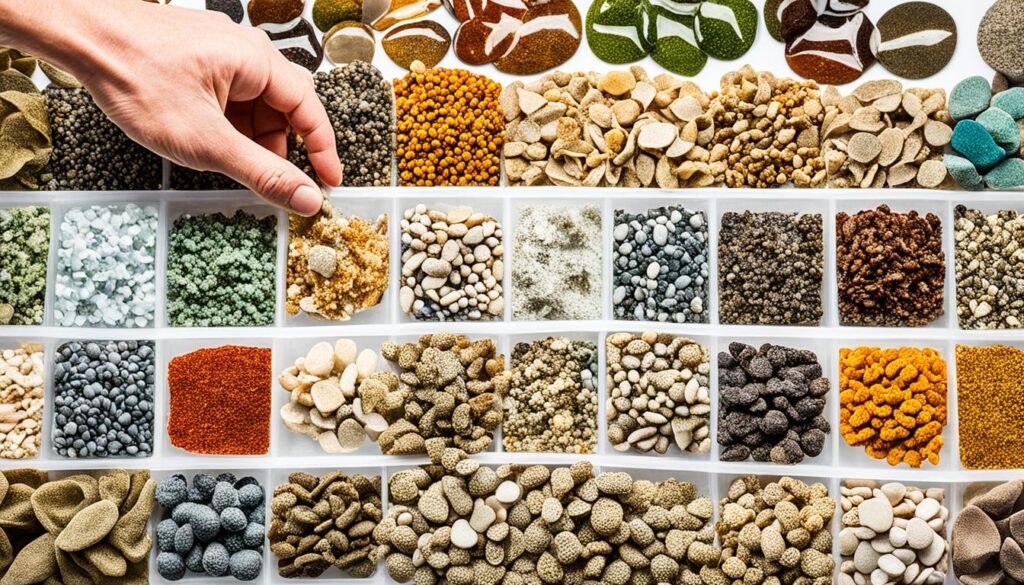
Benefits of Choosing the Right Substrate:
“Choosing the right aquarium substrate not only supports plant growth but also enhances the overall aesthetic appeal of your tank. It’s like the foundation of a beautiful underwater landscape.” – AquaLife Magazine
Best Practices for Layering Substrates in Freshwater Aquariums
To ensure a healthy and thriving fish tank environment, it is essential to follow best practices for layering substrates in your freshwater aquarium. By creating a well-planned and properly arranged substrate layer, you can provide the necessary support, nutrients, and aesthetic appeal for your aquarium inhabitants.
Create a Base Layer of Nutrient-Rich Substrate
Start by creating a base layer of nutrient-rich substrate at the bottom of your aquarium. This layer provides essential nutrients for plant growth and acts as a foundation for the rest of the substrate layers. Consider using organic soil or aquasoil as they are known to be effective in promoting plant health.
Add a Cap Layer of Sand or Gravel
Once you have the base layer in place, add a cap layer of sand or gravel. This layer serves as a protective barrier, preventing the nutrient-rich substrate from leaching into the water column and causing water quality issues. Sand or gravel also provides a natural and visually appealing top layer.
Consider Adding a Decorative Layer
If you want to enhance the aesthetic appeal of your aquarium, consider adding a decorative layer on top of the cap layer. This layer can consist of colored gravel or sand, creating a visually stunning underwater landscape. Be sure to choose materials that are safe for aquarium use and complement the overall theme of your tank.
By following these best practices, you can create a well-layered substrate that supports the health and growth of your aquarium’s plants and fish. Remember to consider the specific needs of your aquatic inhabitants when selecting substrate materials and regularly maintain and monitor your substrate for long-term success.
| Best Practices for Substrate Layering in Fish Tanks |
|---|
| Create a base layer of nutrient-rich substrate |
| Add a cap layer of sand or gravel |
| Consider adding a decorative layer for aesthetic purposes |
Step-by-Step Guide to Layering Substrates in Aquariums
Creating a well-layered substrate is essential for maintaining a healthy and visually appealing freshwater aquarium. Follow these step-by-step instructions to ensure proper substrate arrangement:
- Clean and Prepare: Start by thoroughly cleaning and preparing your aquarium. Remove any existing substrate or debris to provide a clean foundation.
- Add the Base Layer: Begin by adding the base layer of nutrient-rich substrate to the bottom of the tank. Ensure an even distribution across the entire surface.
- Place the Cap Layer: On top of the base layer, carefully place the cap layer of sand or gravel. This layer will create a smooth and level surface for your aquarium.
- Optional: Add a Decorative Layer: If desired, you can add a decorative layer of substrate to enhance the visual appeal of your aquarium. Choose a substrate that complements your aquatic plants and fish species.
- Rinse Thoroughly: Before adding water to the tank, rinse the substrate thoroughly to remove any dirt or dust particles. This will help maintain water clarity and prevent hazy conditions in the aquarium.
Following these steps will ensure that your substrate layers are properly arranged, providing a stable foundation for aquatic plants and a visually pleasing environment for your fish. Remember to always consider the specific needs of your aquarium inhabitants and choose substrates accordingly.
Image:
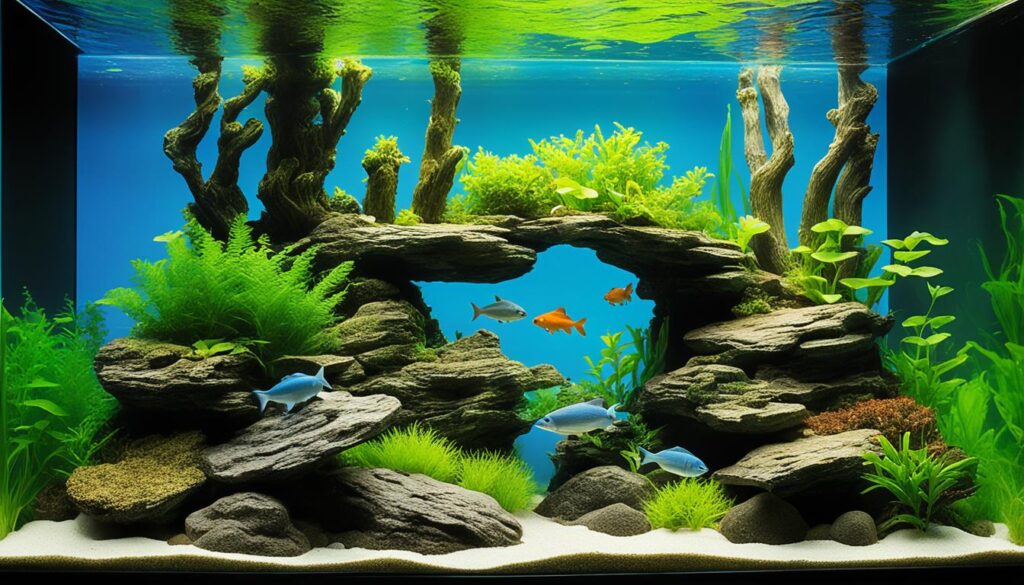
Considerations for Different Types of Substrates
When it comes to choosing the right substrate for your freshwater aquarium, there are several factors to consider. Each type of substrate has its own unique characteristics and considerations that can impact the overall health and maintenance of your aquarium. Let’s take a closer look at some common substrates and the considerations to keep in mind when selecting the right one for your aquarium.
Sand
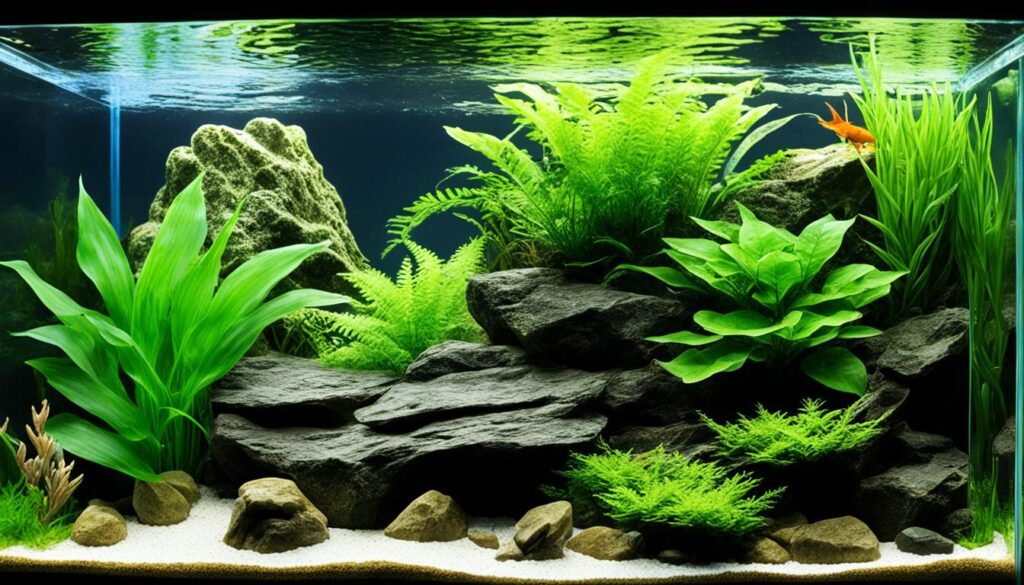
Sand is a popular choice for freshwater aquariums because of its natural appearance and ease of cleaning. It is particularly suitable for bottom-dwelling fish, such as catfish or loaches, as it mimics their natural habitat. However, sand can be prone to compaction, which can limit water circulation and hinder the growth of plant roots. To prevent this, regular stirring or agitating of the sand is necessary to maintain its health and prevent anaerobic conditions.
Gravel
Gravel is another commonly used substrate in freshwater aquariums. It offers a more natural look compared to sand and provides better water circulation within the substrate. This can be beneficial for the overall health of the aquarium and helps prevent the buildup of debris. However, gravel can also trap debris, making it important to perform regular gravel vacuuming to maintain water quality. Additionally, smaller fish species or those with delicate fins may be at risk of injury from sharp-edged gravel, so consider the needs of your fish when choosing gravel as a substrate.
Clay
Clay substrates, such as ADA Aqua Soil, are often chosen for their ability to hold nutrients and provide optimal conditions for plant growth. These substrates can significantly enhance the growth and development of aquatic plants, creating lush and vibrant underwater landscapes. However, clay substrates may release excessive amounts of ammonia initially, requiring careful monitoring of water parameters and gradual introduction of livestock to the aquarium.
Organic Soil
Organic soil substrates are rich in nutrients and provide a fertile environment for aquatic plants. They can be particularly beneficial for demanding plants with high nutrient requirements. However, organic soil substrates can break down over time, depleting their nutrient content. Regular supplementation or replacement may be necessary to maintain optimal plant growth.
Consider the Needs of Your Aquarium Inhabitants
When selecting the type of substrate for your freshwater aquarium, it’s crucial to consider the specific needs of your aquarium inhabitants. Different fish species have varying preferences for substrate types and require specific conditions for optimal health. Furthermore, some substrates may interact with water chemistry and affect pH or hardness levels. Research the requirements of your fish to ensure that the chosen substrate aligns with their needs.
Maintenance Considerations
Lastly, consider the maintenance requirements associated with different substrate types. Some substrates may require more frequent cleaning or agitation to maintain their health and prevent potential issues. Balancing aesthetics with practicality is important, so choose a substrate that aligns with your maintenance capabilities and goals.
By carefully considering the different types of substrates and their associated considerations, you’ll be able to choose the right substrate for your freshwater aquarium. Remember to prioritize the needs of your aquarium inhabitants and select a substrate that provides them with a comfortable and thriving environment.
Maintaining Substrates in Freshwater Aquariums
Regular maintenance is crucial to keep the substrates in your freshwater aquarium in optimal condition. By following these substrate maintenance tips, you can ensure the longevity and health of your aquarium ecosystem:
Vacuuming the Substrate
To remove debris and prevent the buildup of organic matter, it is essential to regularly vacuum the substrate. Use a specialized aquarium gravel vacuum to gently suction out excess waste without disturbing the substrate layers. This practice helps maintain water clarity and prevents the accumulation of harmful substances that can affect the health of your fish and plants.
Stirring the Substrate
Stirring the substrate periodically is necessary to prevent compaction. Over time, the layers of substrate can become compacted, limiting water circulation and inhibiting the root growth of aquatic plants. Use a gentle tool, like an aquarium gravel rake or your fingers, to lightly stir the substrate. This process helps loosen the substrate, improving aeration and nutrient absorption.
Replacing Depleted Substrate
Over time, the nutrient-rich substrate may become depleted, especially if you have heavy root-feeding plants in your aquarium. Regularly monitor the health of your plants and test the nutrient levels in the water. When necessary, replace the nutrient-rich substrate layer to ensure a continuous supply of essential elements for plant growth.
Monitoring Water Parameters
Water parameters play a crucial role in maintaining the overall health of your aquarium, including the condition of the substrate. Regularly test the pH and nitrate levels to ensure they are within the appropriate range for the inhabitants of your tank. If any imbalances are detected, take appropriate measures to restore the optimal conditions. This proactive approach helps create a harmonious environment for fish, plants, and other aquatic organisms.
“Regular substrate maintenance is essential to promote a thriving aquatic environment and prevent potential issues. By vacuuming the substrate, stirring it to prevent compaction, replacing depleted substrate, and monitoring water parameters, you can enjoy a healthy and visually stunning freshwater aquarium.” – Substrate Enthusiast
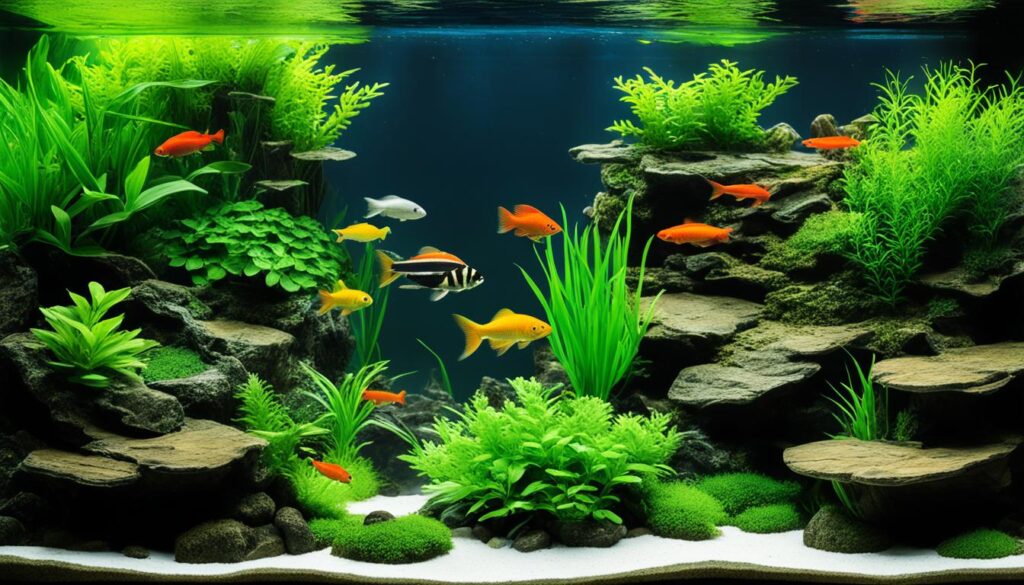
| Maintenance Task | Frequency |
|---|---|
| Vacuuming the Substrate | Once a week |
| Stirring the Substrate | Every 2-3 weeks |
| Replacing Depleted Substrate | As needed |
| Monitoring Water Parameters | Regularly, according to specific needs |
Troubleshooting Common Substrate Issues
While proper substrate layering can provide a healthy environment for your aquarium, it’s important to be aware of common problems that may arise. By understanding the underlying causes of these issues and taking appropriate actions, you can address and prevent potential problems.
Nutrient Imbalances
Nutrient imbalances can occur when there is an excess or deficiency of certain elements in the aquarium substrate. This can lead to poor plant growth or algae overgrowth. To troubleshoot this issue, test the water parameters and adjust the nutrient levels accordingly. Consider using fertilizers or additives to provide the necessary nutrients for your plants.
Algae Growth
Excessive algae growth is a common problem in aquariums, often caused by an imbalance of light, nutrients, or carbon dioxide. To troubleshoot algae growth, ensure that you have appropriate lighting levels and a consistent light schedule. Perform regular water changes to maintain water quality and consider adding algae-eating fish or invertebrates to help control algae growth.
Compaction
Compacted substrate can hinder root growth and nutrient absorption, leading to poor plant health. If you notice compaction in your substrate, gently stir it with a substrate rake or your fingers to loosen it. This will promote proper root development and allow for better water circulation. If compaction persists, consider using a substrate vacuum or replacing the substrate altogether.
Cloudiness
Cloudy water or sediment particles in the aquarium can be a result of improper substrate installation or excessive disturbance. To troubleshoot cloudiness, perform regular water changes and use a mechanical filter to remove suspended particles. Ensure proper rinsing and cleaning of the substrate before adding it to the aquarium.
| Common Substrate Issues | Troubleshooting Tips |
|---|---|
| Nutrient imbalances | Test water parameters, adjust nutrient levels, use fertilizers or additives |
| Algae growth | Ensure appropriate lighting levels, maintain water quality, consider algae-eating fish or invertebrates |
| Compaction | Stir the substrate to loosen it, promote root development, consider using a substrate vacuum |
| Cloudiness | Perform water changes, use a mechanical filter, ensure proper substrate rinsing and cleaning |
By addressing these common substrate issues promptly, you can maintain a healthy and visually appealing aquarium environment for your fish and plants.
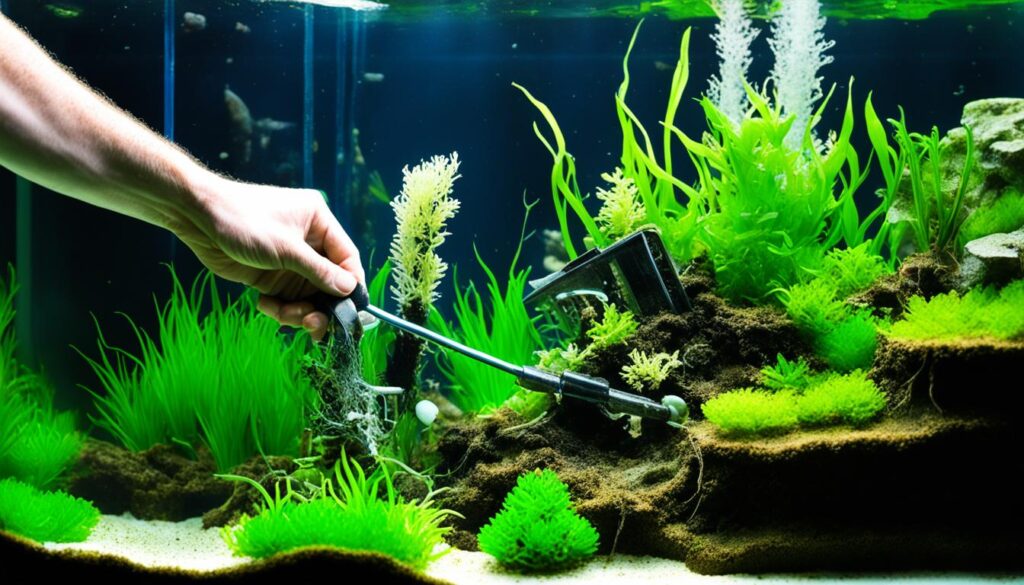
Enhancing the Aesthetic Appeal of Substrate Layering
When it comes to designing your aquarium, substrate layering offers a wonderful opportunity for creativity and artistry. By considering different colors and textures of substrate, you can create a visually stunning underwater landscape that is sure to captivate anyone who lays eyes on it.
One way to enhance the aesthetic appeal of your substrate layers is by using a variety of colors. By incorporating different hues into your design, you can create a sense of depth and visual interest. Imagine the vibrant contrast between a lush green carpeting plant surrounded by a bed of golden sand – it’s like a work of art!
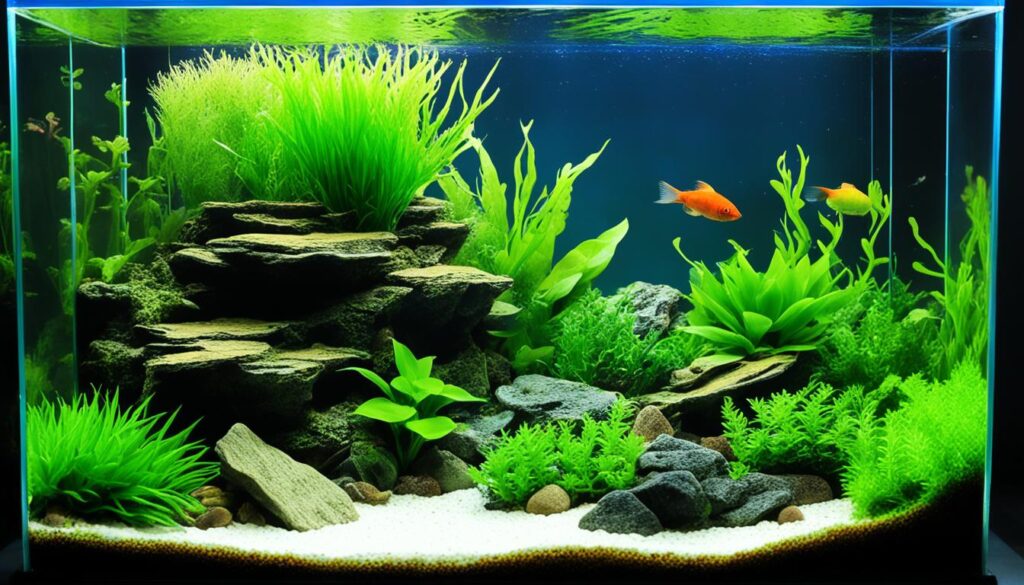
Another technique to explore is incorporating different substrate textures. For example, you might choose to combine smooth sand with coarse gravel or small pebbles. This contrast in textures can add visual intrigue to your aquarium and provide a more dynamic and natural appearance.
“Creating visually appealing substrate layers allows you to transform your aquarium into a captivating underwater paradise.”
– [Real Name], Aquascaping Enthusiast
Don’t be afraid to experiment with various arrangements and compositions. Consider sloping the substrate layers to create a sense of elevation or focal points where plants or decorative elements become the centerpiece of your aquarium. These artistic touches can elevate the overall aesthetic appeal of your underwater world.
Create a Stunning Substrate Composition
Imagine the possibilities of combining different colors and textures of substrate to create a show-stopping aquascape. Here’s an example of a visually appealing substrate composition:
| Layer | Substrate Type | Color/Texture |
|---|---|---|
| Base Layer | Organic Soil | Dark brown, nutrient-rich |
| Cap Layer | Sand | Golden, fine texture |
| Decorative Layer | Colored Gravel | Vibrant red, medium texture |
With this composition, you can create a visually striking aquarium with contrasting colors and textures, adding depth and dimension to your underwater landscape.
Remember, the key to enhancing the aesthetic appeal of your substrate layering is to explore different colors, textures, and arrangements. Let your creativity flow and design a stunning aquascape that will become the centerpiece of your home or office.
Benefits of Proper Substrate Layering in Freshwater Aquariums
Proper substrate layering in freshwater aquariums offers numerous benefits that contribute to the overall health and aesthetics of the aquatic environment. By implementing a well-thought-out substrate layering technique, you can create a thriving habitat for your fish and plants. Let’s explore the advantages of layered substrates in fish tanks:
1. Enhanced Plant Growth and Stability
One of the key benefits of proper substrate layering is the promotion of healthy plant growth. By providing a stable base for plant roots to anchor in, layered substrates enable plants to establish strong root systems. This allows them to absorb essential nutrients from the substrate, resulting in vibrant and lush aquatic vegetation. With a robust root network, plants can efficiently take in water and nutrients, leading to accelerated growth and improved overall health.
2. Support for Beneficial Bacteria
A layered substrate serves as a habitat for beneficial bacteria, which play a vital role in maintaining water quality. Beneficial bacteria break down harmful substances, such as ammonia and nitrites, into less toxic forms, creating a healthier environment for your fish. The proper layering of substrates provides these bacteria with a suitable medium to colonize and thrive, ensuring effective biological filtration in the aquarium.
3. Visual Appeal and Natural Aesthetics
Aesthetics are an important aspect of any aquarium, and proper substrate layering can greatly enhance the visual appeal of your freshwater tank. By carefully selecting and arranging different types of substrates, you can create a natural-looking underwater landscape that mimics the habitats of fish and plants. Whether you prefer a sandy beach, a lush riverbed, or a rocky shoreline, the options are endless when it comes to designing visually stunning substrate layers.
“Proper substrate layering provides stability for plants, supports beneficial bacteria, and enhances the overall visual appeal of the aquarium.”
To visualize the benefits of proper substrate layering, consider the table below, which compares the advantages of different substrate layering techniques:
| Advantages | Base Layer Only | Base Layer + Cap Layer | Base Layer + Cap Layer + Decorative Layer |
|---|---|---|---|
| Stable plant growth | No | Yes | Yes |
| Support for beneficial bacteria | No | Yes | Yes |
| Enhanced visual appeal | No | Yes | Yes |
As shown in the table, the inclusion of a cap layer and a decorative layer on top of the base layer offers additional benefits, such as stability for plant growth and improved visual appeal. However, even a base layer alone can still provide some advantages over a tank without any substrate layering.
By understanding the benefits of proper substrate layering, you can create a healthy and visually stunning freshwater aquarium that provides a thriving habitat for your aquatic pets.
Conclusion
In conclusion, layering substrates in freshwater aquariums is a vital step in creating a thriving and visually appealing aquatic environment. Following the steps outlined in this guide, I hope you have gained the knowledge and confidence to successfully layer substrates in your own aquarium. By considering the specific needs of your fish and aquatic plants, you can create a habitat that promotes their health and well-being.
Remember, proper maintenance and regular monitoring of your substrate is essential for long-term success. Keeping the substrate clean and free from debris, as well as monitoring water parameters, will ensure a balanced and healthy aquarium ecosystem. With a well-layered substrate, you can enjoy the beauty and benefits of a vibrant and flourishing underwater landscape.
Thank you for reading this guide on how to layer substrates in freshwater aquariums. I hope it has provided you with valuable insights and useful tips. Now it’s time to dive in and create your own stunning underwater masterpiece!
FAQ
Why is substrate layering important in freshwater aquariums?
Substrate layering is important in freshwater aquariums because it provides support for plants, serves as a source of nutrients for aquatic plants, and enhances the overall visual appeal of the aquarium.
How do I choose the right aquarium substrate?
When choosing the right aquarium substrate, consider the needs of your plants and the desired aesthetic effect. Popular choices include gravel, sand, clay, ADA Aqua Soil, and organic soil.
What are the best practices for layering substrates in freshwater aquariums?
The best practices for layering substrates in freshwater aquariums include creating a base layer of nutrient-rich substrate, adding a cap layer of sand or gravel, and optionally adding a decorative layer for aesthetic purposes.
How do I layer substrates in my freshwater aquarium?
To layer substrates in your freshwater aquarium, start by cleaning and preparing the aquarium. Then, add a base layer of nutrient-rich substrate followed by a cap layer of sand or gravel. Optionally, add a decorative layer. Rinse the substrate before adding water to the tank.
What considerations should I keep in mind for different types of substrates?
Different substrates have different considerations. For example, sand is ideal for bottom-dwelling fish but may require frequent stirring. Gravel offers better water circulation but can trap debris. Consider the needs of your aquarium inhabitants and the maintenance requirements.
How do I maintain substrates in freshwater aquariums?
To maintain substrates in freshwater aquariums, perform regular vacuuming to remove debris, stir the substrate to prevent compaction, and replace nutrient-rich substrate when depleted. Monitor water parameters for balance.
What are common substrate issues and how do I troubleshoot them?
Common substrate issues include nutrient imbalances, algae growth, compaction, and cloudiness. Troubleshoot these issues by adjusting nutrient levels, increasing water circulation, and performing regular substrate maintenance.
How can I enhance the aesthetic appeal of substrate layering?
You can enhance the aesthetic appeal of substrate layering by using different colors or textures of substrate, creating depth and visual interest. Experiment with arrangements like sloping or focal points.
What are the benefits of proper substrate layering in freshwater aquariums?
Proper substrate layering provides stability for plants, promotes the growth of beneficial bacteria, and enhances the visual appeal of the aquarium, creating a beautiful and natural-looking underwater landscape.
